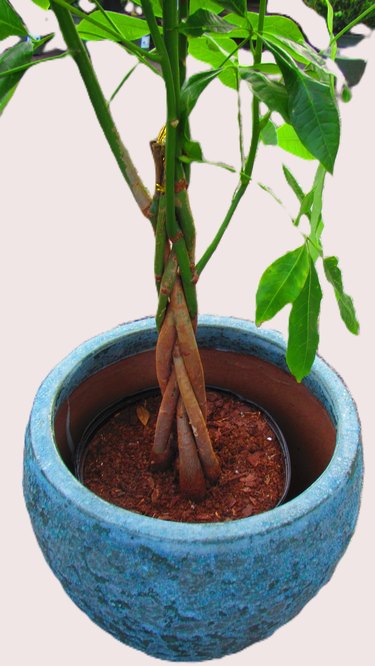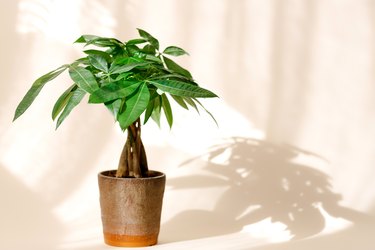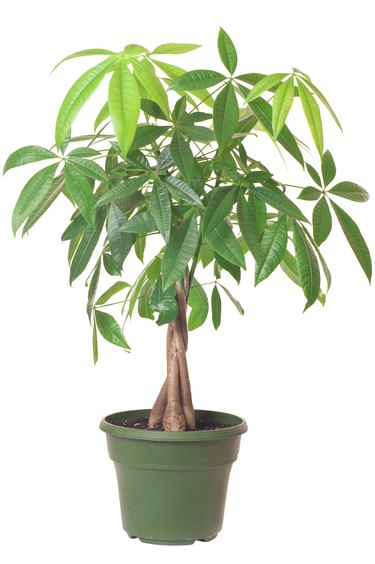One of the most common New Year's resolutions is improving finances. And who couldn't use a little financial luck at any time of the year? So, bring a money tree into your life! It's a small tree, often with a braided trunk, crowned by a canopy of bright, shiny leaves.
While the charming houseplant known as the money tree does not come with a guarantee of a financial windfall, those who practice feng shui associate it with the best kind of energy for attracting good fortune. This happy little tree will add beauty to your living space, and money tree care couldn't be easier!
Video of the Day
Video of the Day
Money Tree Overview
Common name: Money tree/money plant/Guiana chestnut
Botanical name: Pachira aquatica
Mature size: 6–8 feet
Sun exposure: Needs about six hours of bright, indirect sun each day
Water: Water whenever the top inch of soil is dry. Be careful not to overwater.
Soil: Moist soil with sharp drainage
Toxicity: Safe for dogs and cats
USDA hardiness zones: 10–12
Why Is It Called a Money Tree?
While there is no scientific research that indicates that bringing a money tree into your home will improve your finances, the houseplant is widely considered a lucky plant. It is said to bring good fortune, wealth, prosperity, and abundance.
The plant owes its reputation to Chinese mythology, in which this plant is deemed sacred and able to bestow good luck and good fortune on those around it. The money tree's stalks, when young and flexible, are often sold with braided stems that form a trunk. The luckiest plant will have five braided stems, each representing one of the five elements of the universe (water, fire, earth, air, and metal).
The money tree is also considered a powerful entity in feng shui, the ancient method of arranging homes and businesses in a particular fashion to encourage harmony and abundance. Feng shui is based on the idea that everything on the planet is alive and full of energy, called chi. The money tree is believed to attract positive chi and fortune while fending off bad energy.
Some believe that you can increase the plant's power to bring luck by decorating it with coins and ribbons. And placing the money tree plant in a part of your home where you pay bills or deal with money is also said to encourage good luck and good fortune.
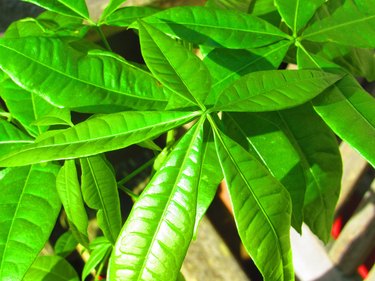
Other "Money Plants"
Note that Pachira aquatica is not the only houseplant optimistically called the money tree or plant. Others are too — many others — so be careful of what you read on the internet. Characteristics may apply to one money plant but not to the one you have, and their cultural care requirements may be different. Some are toxic, and some are not. Use the scientific name to look up information.
When we talk about the money tree here, we are always referring to Pachira aquatica. But here is a short list of plants that are sometimes called "money plants" or "money trees."
- Crassula ovata is sometimes called the money plant, but it is more often called the
jade plant. This is a succulent that's the color of the precious jade stone, said in feng shui to promote luck and long life.
- Pilea peperomioides is another plant given the nickname "money tree." It is also known as the coin plant or the Chinese money plant. Its shiny leaves are round as coins.
- Epipremnum aureum is a plant we know and love as golden pothos, but it's also called the money plant. Scientists have established that this plant can purify the air of toxins.
- Xerosicyos danguyi, also called the money plant or the silver dollar vine, is another succulent, and its coin-size succulent leaves adorn the climbing stems. It is said to bring wealth to a household.
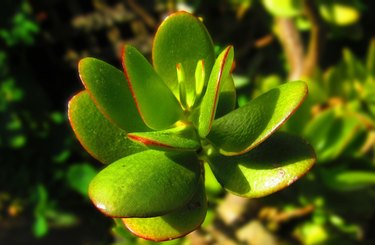
Money Plant Benefits
The one benefit of a healthy money tree we can promise you is that it will add beauty and focus to any room in which it is placed. These small trees are visually striking, with dark, barklike stems often braided together when they are young and flexible, topped with vibrant glossy green leaves. They look for all the world like a bonsai palm tree, but they are easy-care plants that are tolerant of growing conditions.
Does the money plant purify the air? Not this one, but another houseplant that is sometimes called a money tree plant does. That is Scindapsus aureus/Epipremnum aureum, a foliage houseplant more commonly known as the golden pothos.
What about money and fortune? What can we say? If you believe that the plant will bring you good luck, it very well might.
Money Tree Light Requirements
The Pachira aquatica money tree grows best in bright, indirect light. This allows it to achieve its best form, with a gorgeous brown braided trunk and a canopy of shiny leaves. Remember that these plants are native to the tropics of Central and South America, where they grow in bright, indirect light. They may not die in shade, but they will never be at their best. Give them six hours of indirect sun and watch them develop into show-stoppers.
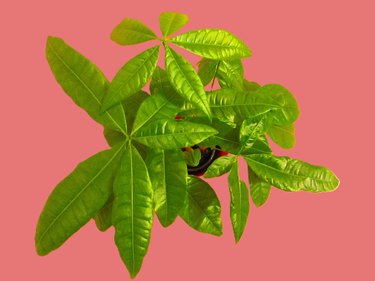
Money Tree Soil (Requirements)
The easiest way to kill a money tree is to overwater it. While this may result from too much water, it usually is the soil at fault. Excellent drainage is key, and clay soil that holds water just won't make it. The soil doesn't have to be exotic, however. A simple potting mix from the garden store is good enough as long as it drains well. And be sure that its pot has drain holes!
Money Tree Water Requirements
Don't confuse this type of money tree with pothos that can go for weeks on end without water. Money trees need regular water. Add a generous amount whenever the top inch of the soil in the container is dry. What does this look like in real life? It means watering about once a week in spring and summer and a bit less in fall and winter.
Note that water in the air (humidity) is also important to the money tree. For best results, purchase a small humidifier and place it near the tree.
Money Tree Fertilizer
The money tree is not a stickler for fertilizer, but it won't hurt the plant if you don't overdo it. If you wish to feed the plant, use a balanced houseplant fertilizer at half strength. Apply it once a month during the growing season and once every two months in fall and winter.
How to Prune a Money Tree
Pruning your money tree can help the plant remain vigorous and healthy. The best time to act is during the growing season. Trim out any dead or broken plant parts. You can encourage a bigger canopy for the tree by pruning out lower leaves. If you trim off stems, you can root them and create new plants.
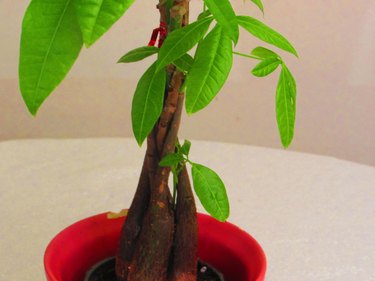
Money Tree Propagation
Money tree plants of this species propagate readily from stem cuttings. Take them during the active growth period, making each between 4 and 6 inches long with a few leaf nodes. Take off the lower leaves of the cuttings and then root them in water. When the roots are several inches long, transplant them into a small pot filled with well-draining soil and place it in indirect light.
Money Tree Braiding
Many Pachira aquatica money trees are sold commercially with braided trunks. But if you propagate your own new trees, you can do your own braiding. The idea is to braid 3 or 5 young, thin, flexible stems together into one trunk and repot them as one plant. You'll need plants with stems at least 12 inches long.
Remove the plants from their containers and trim off leaves that will impede braiding. Braid the stems, holding them together with a twist tie when necessary. This is the way to do it:
- Take the young plants out of their pots. Remove any leaves that will interrupt braiding.
- Loosely braid the stems. "Loosely" is the operative word here. Don't tighten the braid! As the stems mature, they get bigger.
- If necessary, use a twist tie to hold the end of the braid together.
- Combine the plants in one pot, keeping it upright with a stake.
- Allow the new plant to adjust to its new circumstances in a shady area. This will take at least a month. When it has recovered and appears healthy, remove the twist tie and move it into indirect light.
